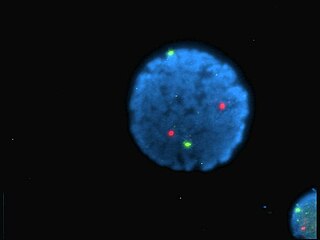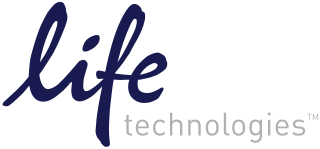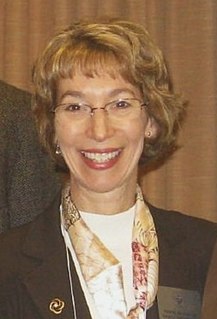Molecular Probes was a biotechnology company located in Eugene, Oregon specializing in fluorescence. The company was founded in 1975 by Richard and Rosaria Haugland in their kitchen in Minnesota, then moved briefly to Texas and finally to Oregon in the early 1980s.

Biotechnology is the broad area of biology involving living systems and organisms to develop or make products, or "any technological application that uses biological systems, living organisms, or derivatives thereof, to make or modify products or processes for specific use". Depending on the tools and applications, it often overlaps with the (related) fields of molecular biology, bio-engineering, biomedical engineering, biomanufacturing, molecular engineering, etc.

Eugene is a city in the U.S. state of Oregon. It is at the southern end of the verdant Willamette Valley, near the confluence of the McKenzie and Willamette Rivers, about 50 miles (80 km) east of the Oregon Coast.
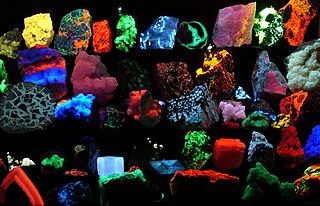
Fluorescence is the emission of light by a substance that has absorbed light or other electromagnetic radiation. It is a form of luminescence. In most cases, the emitted light has a longer wavelength, and therefore lower energy, than the absorbed radiation. The most striking example of fluorescence occurs when the absorbed radiation is in the ultraviolet region of the spectrum, and thus invisible to the human eye, while the emitted light is in the visible region, which gives the fluorescent substance a distinct color that can be seen only when exposed to UV light. Fluorescent materials cease to glow nearly immediately when the radiation source stops, unlike phosphorescent materials, which continue to emit light for some time after.
In 1989, Molecular Probes moved from Junction City to its current location in Eugene. While in Texas, the Hauglands developed the Texas Red dye, a rhodamine derivative. Other dyes have names that reflect their Oregon heritage, including the Oregon Green and Cascade Blue dyes, while Marina Blue and the Alexa Fluor dyes are named after the Hauglands' children, Marina and Alex.
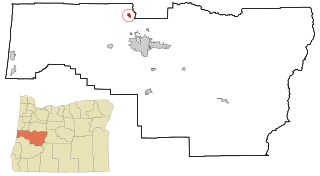
Junction City is a city in Lane County, Oregon, United States. Its population was 5,392 at the 2010 census.

Texas Red or sulforhodamine 101 acid chloride is a red fluorescent dye, used in histology for staining cell specimens, for sorting cells with fluorescent-activated cell sorting machines, in fluorescence microscopy applications, and in immunohistochemistry. Texas Red fluoresces at about 615 nm, and the peak of its absorption spectrum is at 589 nm. The powder is dark purple. Solutions can be excited by a dye laser tuned to 595-605 nm, or less efficiently a krypton laser at 567 nm. The absorption extinction coefficient at 596 nm is about 85,000 M−1cm−1.

Rhodamine is a family of related chemical compounds, fluorone dyes. Examples are Rhodamine 6G and Rhodamine B. They are used as dyes and as dye laser gain media. They are often used as a tracer dye within water to determine the rate and direction of flow and transport. Rhodamine dyes fluoresce and can thus be detected easily and inexpensively with instruments called fluorometers. Rhodamine dyes are used extensively in biotechnology applications such as fluorescence microscopy, flow cytometry, fluorescence correlation spectroscopy and ELISA.
Invitrogen bought Molecular Probes in 2003 for approximately $325 million in cash. [1] The business subsequently became a part of Life Technologies, through the merger of Invitrogen and Applied Biosystems, and is now part of Thermo Fisher Scientific, following Thermo Fisher's acquisition of Life Technologies in 2014.
Invitrogen is one of several brands under the Thermo Fisher Scientific corporation. The product line includes various subbrands of biotechnology products, such as machines and consumables for polymerase chain reaction, reverse transcription, cloning, culturing, stem cell production, cell therapy, regenerative medicine, immunotherapy, transfection, DNA/RNA purification, diagnostic tests, antibodies, and immunoassays.
Applied Biosystems is one of the various brands under the Life Technologies brand of Thermo Fisher Scientific corporation. The brand is focused on integrated systems for genetic analysis, which include computerized machines and the consumables used within them.
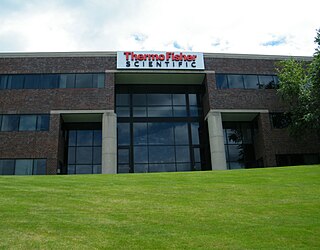
Thermo Fisher Scientific is an American biotechnology product development company located in Waltham, Massachusetts, and was created in 2006 by the merger of Thermo Electron and Fisher Scientific. In April 2013, after a competitive bidding with Hoffmann-La Roche, Thermo Fisher acquired Life Technologies Corporation for US$13.6 billion in a deal that would rank the firm as one of the leading companies in the genetic testing and precision laboratory equipment markets.
